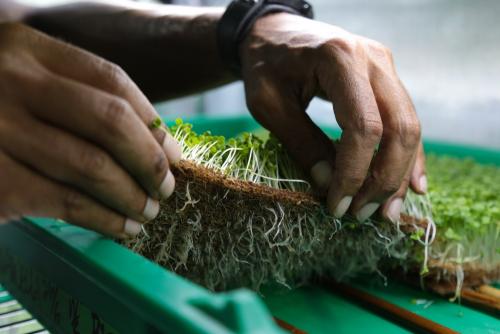How to Grow Organic Produce at Home Year-Round

Do you know that you can grow organic produce at home throughout the year? Now you know! This article incorporates a guide that can help you manage to grow organic produce throughout the year. Read through for more information.
Prioritize the Use of Organic Soil Fertilizer
Growing organic produce at home is much like growing conventional produce. However, you need to add more fertilizers to increase the yield and quality of the fruits and vegetables that you are growing. Ingredients for organic fertilizer can be bought through a nursery or store. There are two kinds of soil used in gardening: organic soil and inorganic soil.
Organic soil fertilizer contains compost, which is the best type of organic fertilizer. This kind of fertilizer has a rich organic composition that will provide the plants with the nutrients they require and ensure that people are eating organically grown products. On the flip side, inorganic fertilizers do not have enough nutrients and usually contain chemicals like ammonium phosphate, calcium nitrate, and monopotassium phosphate.
Practice Crop Rotation
There will be times when your soil becomes depleted of nutrients. When this happens, you need to practice crop rotation to restore your soil's quality and quantity of nutrients. Note that it is better to plant a variety of different crops to prevent the depletion of nutrients in your soil, rather than growing one kind of crop over and over again.
Apply Mulch
Mulch is another essential requirement when it comes to planting at home and producing organic produce. Mulch adds nutrients as well as prevents erosion. It also can protect the quality and growth of plants, particularly from the rays of direct sunlight. You should ensure that the mulch you use is made of organic material. This can be wood chips or leaves.
Ensure Your Home Garden is Clean Throughout the Year
You should clean out your garden regularly, whether you are growing organic produce or conventional produce. Always remove the weeds and pluck off other unwanted plants to prevent your plants from getting the necessary nutrients. Note that if you leave any kind of plant overgrown, it is most likely to steal away the nutrients from the soil.
Remember that weeds compete with the plants in terms of nutrient intake. If you have too many weeds growing in your garden, then your plants will likely produce low yields due to nutrient competition with the weeds.
Water the Plants Wisely and Give Room for Air Circulation
Ensure that you properly water your plants. Avoid overwatering, which can lead to fungus and rot. Instead of pouring water on the leaves, spray the tops of the soil with a watering can so that the moisture can easily seep into the ground where the roots are located. It is also vital to ensure that you are giving plants enough room for air circulation.
By doing this, moisture will evaporate quickly so that the land does not become too wet or soggy. If your garden is in an area that gets direct sunlight for most of the day, make sure to cover the soil with black mulch to prevent it from getting too hot and overly moist.
Pick the Right Garden Location
When growing organic produce at home, it is vital to make sure that you grow your plants in a suitable and ideal location. If possible, choose an area with more natural light, but away from the sun's direct rays. This will prevent overstimulation of plants, which will eventually lead to a decrease in the quantity and quality of produce.
Growing produce at home doesn’t have to be a seasonal endeavor. By utilizing modern tools like sun-replicating light fixtures and modern irrigation systems, you can learn to grow fresh produce year-round. You can convert practically any environment within your home, into a high-yielding vegetable paradise. Instead of a garage or room within your house filled with clutter, try exploring ways that you can make use of your homes dead space.
Use a Variety of Planting Methods
There are various ways to plant crops, so be sure to use a variety of methods. Some people grow their plants using raised beds, while others dig holes in the ground and place their seeds directly into the pits for root crops. Some home growers choose to grow microgreens and veggies indoors by using vertical growing systems. Having said that, it is your choice as to how you want to plant your crop, and what kind of crops you’d like to grow. There are many options to keep your home supplied year-round.
Note that when it comes to growing fruits and veggies, you will need various plants like tomatoes, kohlrabi, cauliflower, and peppers. Planting two or three different types of the same vegetable is imperative as this can prevent pests from attacking all of the crops in your garden at once. If you have raised beds, make sure to plant your plants close together. This will not only promote a healthy environment for the plants but also save space.
The above-discussed tips can help you grow organic produce at home throughout the year without experiencing any challenge. Also, these tips will help you grow healthy plants with great nutritional value.
Post Your Ad Here
Comments